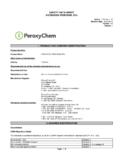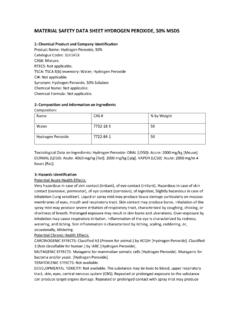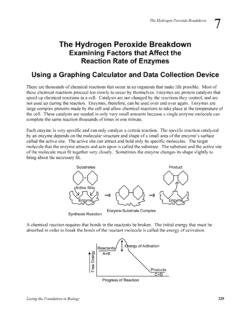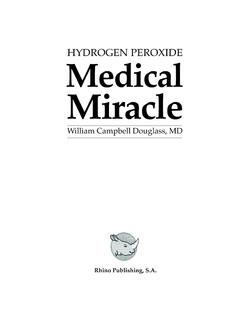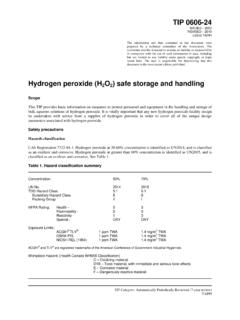Transcription of SAFETY DATA SHEET HYDROGEN PEROXIDE, 50%
1 SAFETY data SHEET HYDROGEN peroxide , 50% SDS HYDROGEN peroxide , 50% Page 1 of 9 1. PRODUCT AND COMPANY IDENTIFICATION Product Information Product name: HYDROGEN peroxide 50% (ALL GRADES) Synonyms: H2O2 50% Molecular formula: H2O2 Chemical family: peroxides Molecular weight: g/mol Product use: Bleaching agent, Oxidizing agent, Cosmetics, Water treatment Details of the supplier of the SAFETY data SHEET Co mpany Compass Remediation Chemicals 2028 East Ben White Blvd #240-1974 Austin, TX 78741 Tele phone (866) 221-9167 Emergency telephone number Emergency Phone #: CHEMTREC 1-800-424-9300 2. HAZARDS IDENTIFICATION Emergency Overview Color: colorless Physical state: liquid Odor: pungent *Classification of the substance or mixture: Oxidizing liquids, Category 2, H272 Oral: Acute toxicity, Category 3, H301 Skin corrosion, Category 1C, H314 Serious eye damage, Category 1, H318 Specific target organ toxicity - single exposure, Category 3, H335 Chronic aquatic toxicity, Category 3, H412 *For the full text of the H-Statements mentioned in this Section, see Section 16 GHS-Labelling Hazard pictograms: Signal word: Danger SAFETY data SHEET HYDROGEN peroxide , 50% SDS HYDROGEN peroxide , 50% Page 2 of 9 Hazard Statements: H272 : May intensify fire; oxidiser.
2 H301 : Toxic if swallowed. H314 : Causes severe skin burns and eye damage. H335 : May cause respiratory irritation. H412 : Harmful to aquatic life with long lasting effects. Prevention: P210 : Keep away from heat. P220 : Keep/Store away from clothing/ combustible materials. P221 : Take any precaution to avoid mixing with combustibles. P261 : Avoid breathing gas/mist/vapours/spray. P264 : Wash skin thoroughly after handling. P270 : Do not eat, drink or smoke when using this product. P271 : Use only outdoors or in a well-ventilated area. P273 : Avoid release to the environment. P280 : Wear protective gloves/ protective clothing/ eye protection/ face protection. Response: P301 + P310 : IF SWALLOWED: Immediately call a POISON CENTER or doctor/ physician. P301 + P330 + P331 : IF SWALLOWED: Rinse mouth. Do NOT induce vomiting. P303 + P361 + P353 : IF ON SKIN (or hair): Remove/ Take off immediately all contaminated clothing.
3 Rinse skin with water/ shower. P304 + P340 : IF INHALED: Remove victim to fresh air and keep at rest in a position comfortable for breathing. P305 + P351 + P338 : IF IN EYES: Rinse cautiously with water for several minutes. Remove contact lenses, if present and easy to do. Continue rinsing. P310 : Immediately call a POISON CENTER or doctor/ physician. P363 : Wash contaminated clothing before reuse. P370 + P378 : In case of fire: Use dry sand, dry chemical or alcohol-resistant foam for extinction. Storage: P403 + P233 : Store in a well-ventilated place. Keep container tightly closed. P405 : Store locked up. Disposal: P501 : Dispose of contents/ container to an approved waste disposal plant. Supplemental information: Potential Health Effects: If swallowed: May cause: gastrointestinal symptoms, ulceration, burns, accumulation of fluid in the lungs which may be delayed for several hours, (severity of effects depends on extent of exposure).
4 SAFETY data SHEET HYDROGEN peroxide , 50% SDS HYDROGEN peroxide , 50% Page 3 of 9 3. COMPOSITION/INFORMATION ON INGREDIENTS Chemical Name CAS-No. Wt/Wt GHS Classification** HYDROGEN peroxide 7722-84-1 50 % H271, H301, H332, H335, H314, H318, H412 Water 7732-18-5 50 % Not classified **For the full text of the H-Statements mentioned in this Section, see Section 16. 4. FIRST AID MEASURES Inhalation: If inhaled, remove victim to fresh air. If not breathing, give artificial respiration. If breathing is difficult, give oxygen. Get medical attention immediately. Skin: In case of contact, immediately flush skin with plenty of water for at least 15 minutes while removing contaminated clothing and shoes. Get medical attention immediately. Remove contaminated clothing and shoes. Wash clothing before reuse. Destroy contaminated shoes. Eyes: In case of contact, immediately flush eyes with plenty of water for at least 15 minutes.
5 Get medical attention immediately. Ingestion: If swallowed, DO NOT induce vomiting unless directed to do so by medical personnel. Call a Poison Control Center. If victim is fully conscious, give a cupful of water. Never give anything by mouth to an unconscious person. Rinse mouth. Notes to physician: Exposure to material may cause delayed lung injury resulting in pulmonary edema and pneumonitis. Exposed individuals should be monitored for 72 hours after exposure for the onset of delayed respiratory symptoms. 5. FIREFIGHTING MEASURES Extinguishing media (suitable): water spray, water fog Protective equipment: Fire fighters and others who may be exposed to products of combustion should wear full fire fighting turn out gear (full Bunker Gear) and self-contained breathing apparatus (pressure demand / NIOSH approved or equivalent). Further firefighting advice: Oxidizing material In case of major fire and large quantities: Evacuate area.
6 Fight fire remotely due to the risk of explosion. SAFETY data SHEET HYDROGEN peroxide , 50% SDS HYDROGEN peroxide , 50% Page 4 of 9 Decomposition will release oxygen, which will intensify a fire. Cool closed containers exposed to fire with water spray. Cl osed containers of this material may explode when subjected to heat from surrounding fire. Do not allow run-off from fire-fighting to enter drains or water courses. Fire-fighting equipment should be thoroughly decontaminated after use. Fire and explosion hazards: Solutions above 65% are especially hazardous as they do not contain enough water to remove the heat of decomposition by evaporation. Explosive when mixed with combustible material. Avoid breathing fumes from fire exposed material. 6. ACCIDENTAL RELEASE MEASURES In case of spill or leak: Prevent further leakage or spillage if you can do so without risk. Evacuate area of all unnecessary personnel.
7 Ventilate the area. Eliminate all ignition sources. Avoid generation of vapors. Avoid contact with cellulose, paper, sawdust or similar substances. Risk of self-ignition or promotion of fires. Combustible materials exposed to HYDROGEN peroxide should be rinsed immediately with large amounts of water to ensure that all the HYDROGEN peroxide is removed. Contain and collect spillage with non-combustible absorbent material such as clean sand, earth, diatomaceous earth or non-acidic clay and place into suitable properly labeled containers for prompt disposal. Avoid dispersal of spilled material and runoff and contact with soil, waterways, drains and sewers. Consult a regulatory specialist to determine appropriate state or local reporting requirements, for assistance in waste characterization and/or hazardous waste disposal and other requirements listed in pertinent environmental permits. 7. HANDLING AND STORAGE Handling General information on handling: Do not taste or swallow.
8 Do not get in eyes, on skin, or on clothing. Avoid breathing vapor or mist. Keep from contact with clothing and other combustible materials. Keep away from heat, sparks and flames. Use only with adequate ventilation. Wash thoroughly after handling. Wear fire/ flame resistant/ retardant clothing. Prevent product contamination. Keep only in the original container. Store in tightly closed container. DO NOT CUT, DRILL, GRIND, OR WELD ON OR NEAR THIS CONTAINER. Emptied container retains vapor and product residue. Observe all labeled safeguards until container is cleaned, reconditioned or destroyed. Avoid contamination. Storage General information on storage conditions: Store in tightly closed container. Store in cool, dry, well ventilated area away from sources of ignition such as flame, sparks and static electricity. Store out of direct sunlight in a cool well-ventilated place. Store in original container.
9 Store away from combustibles and incompatible materials. Refer to National Fire Protection Association (NFPA) 430, Code for the Storage of Solid and Liquid Oxidizers. Storage incompatibility General: Store separate from acids, alkalies, reducing agents, and combustibles. Store separate from: Metallic oxides Organic materials SAFETY data SHEET HYDROGEN peroxide , 50% SDS HYDROGEN peroxide , 50% Page 5 of 9 8. EXPOSURE CONTROLS/PERSONAL PROTECTION Airborne Exposure Guidelines: HYDROGEN peroxide (7722-84-1) US. ACGIH Threshold Limit Values Time weighted average 1 ppm US. OSHA Table Z-1 Limits for Air Contaminants (29 CFR ) PEL: 1 ppm ( mg/m3) Only those components with exposure limits are printed in this section. Limits with skin contact designation above have skin contact effect. Air sampling alone is insufficient to accurately quantitate exposure. Measures to prevent significant cutaneous absorption may be required.
10 Limits with a sensitizer designation above mean that exposure to this material may cause allergic reactions. Engineering controls: Investigate engineering techniques to reduce exposures below airborne exposure limits or to otherwise reduce exposures. Provide ventilation if necessary to minimize exposures or to control exposure levels to below airborne exposure limits (if applicable see above).If practical, use local mechanical exhaust ventilation at sources of air contamination such as open process equipment. Consult ACGIH ventilation manual or NFPA Standard 91 for design of exhaust systems. Respiratory protection: Avoid breathing vapor or mist. Where airborne exposure is likely or airborne exposure limits are exceeded (if applicable, see above), use NIOSH approved respiratory protection equipment appropriate to the material and/or its components. Full facepiece equipment is recommended and, if used, replaces need for face shield and/or chemical goggles.

